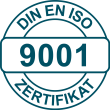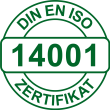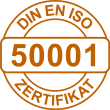LSAM – Large Scale Additive Manufacturing
The future of manufacturing technology for technical plastic parts

Die Zukunft der Fertigungstechnologie für technische Kunststoffteile
You have BIG ideas – we manufacture them in plastic with LSAM
LSAM (Large Scale Additive Manufacturing) combines our many years of expertise in subtractive manufacturing and additive manufacturing. Our new hybrid machining centre is used to produce next-generation plastic components and, in combination with our development know-how, sets new standards.
The manufacturing process starts with the 3D printing of a near-contour blank in which plastic granulate is melted and applied layer by layer by means of an extruder. This additive part is also called Fused Granulate Fabrication FGF or Pellet Extrusion.
Afterwards, the subtractive part, the printed blank is partially or completely machined using 5-axis CNC milling and the excess material is removed to achieve the final shape and surface quality of the part. The finished component offers enormous advantages and enables new levels of freedom for innovative solutions.
The advantages of Hänssler Large Scale Additive Manufacturing (LSAM)

1. larger parts
As the name suggests, LSAM enables the production of parts on a large scale that are not achievable with conventional 3D printing technologies and milling processes. This opens up new possibilities in areas where large, customised parts are needed for which blanks of the necessary size have been previously unavailable.
2. efficiency
LSAM combines additive and subtractive manufacturing processes in a single system. This means that parts can be produced and finished in one pass, which significantly speeds up the production process and increases efficiency. In addition, only a minimum of material is used as the blanks are printed close to contour. Time- consuming milling operations from large blocks with a lot of waste are a matter of the past. In concrete terms, this results in a massive saving of resources in the form of plastic used, energy, transport, tool wear and machining time.

3. material variety
rPETG+GF | rPETG + GF this is an environmentally friendly material consisting of recycled PETG plastic and glass fibres. This composite material combines the good printability and environmental friendliness of rPETG with the increased strength and stiffness of glass fibres, making it an excellent choice for demanding LSAM components. |
ABS+CF | ABS+CF stands for acrylonitrile butadiene styrene with carbon fibre reinforcement. It is a composite material that combines the lightness and strength of carbon fibre with the good processability and durability of ABS plastic. This material offers improved mechanical properties and is ideal for applications that require high strength and rigidity. |
PC+CF | PC+CF stands for polycarbonate with carbon fibre reinforcement. This composite material combines the high impact strength and excellent heat resistance of polycarbonate with the high strength and lightness of carbon fibre. It is ideal for engineering plastic parts that require high mechanical strength, dimensional stability and heat resistance.
|
PEI+CF | PEI+CF stands for polyetherimide with carbon fibre reinforcement. This composite material combines the excellent thermal and chemical resistance of PEI with the high strength and stiffness of carbon fibres. It is ideal for demanding LSAM composite components that require high performance at high temperatures and under harsh conditions. |
PESU+CF | PESU+CF stands for polyethersulfone with carbon fibre reinforcement. This composite material combines the excellent heat resistance and chemical stability of PESU with the high strength and lightness of carbon fibres. It is ideal for demanding LSAM applications that require high performance under extreme conditions, including high temperatures and aggressive chemical environments. |
Unsere LSAM-Experten beraten Sie gerne


Sebastian Hänssler
Our core competencies in the field of LSAM
of the right material
processes
-
Selection of the right material
-
Selection of the right manufacturing process
-
Quality from our own production – everything from a single source
-
networked processes
-
Flexible and on-time production
-
Short and exact delivery times
Das LSAM-Verfahren (Large Scale Additive Manufacturing) von Hänssler ermöglicht uns die Herstellung einer sehr großen Positivform mit optimaler Oberflächenbeschaffenheit und höchster Genauigkeit. Sie bildet die Basis zur Herstellung des Carbon-Monocoques unseres Rennwagens der nächsten Saison. Auch bei der Entwicklungsarbeit und der Auswahl des passenden Werkstoffes wurden wir zu jeder Zeit fachlich betreut und kompetent beraten.
Frequently Asked Questions about Large Scale Additive Manufacturing (LSAM)
Large Scale Additive Manufacturing (LSAM) is a manufacturing process that combines additive and subtractive techniques to produce large scale parts from thermoplastic materials. It is particularly suitable for the production of parts that are difficult to produce using conventional manufacturing methods due to their size or complexity.
LSAM offers a number of advantages, including the ability to produce large parts quickly and efficiently, the use of a wide variety of materials, high precision and quality, and significant cost savings by reducing material consumption and waste.
LSAM is mainly used in sectors that require large, customised parts, such as aerospace, automotive, shipbuilding and wind energy.
LSAM offers industrial companies the potential to optimise their production processes, reduce costs, improve product quality and develop innovative products that would not be possible with conventional manufacturing methods.
LSAM has a positive impact on environmental aspects as it reduces material consumption and waste, improves energy efficiency and offers the possibility to use recycled or bio-based materials.
LSAM can lead to significant cost savings by shortening production times, reducing material consumption and waste, and eliminating the need for additional assembly or joining steps. It can also lead to indirect cost savings by improving efficiency and productivity.
LSAM can improve product quality by offering high precision and surface quality, as well as the ability to create complex internal structures and geometries that would not be possible with traditional manufacturing methods. It also enables the use of high performance materials and composites that can lead to improved mechanical properties and performance.
LSAM can improve product quality by offering high precision and surface quality, as well as the ability to create complex internal structures and geometries that would not be possible with traditional manufacturing methods. It also enables the use of high performance materials and composites that can lead to improved mechanical properties and performance.
LSAM enables high precision and surface quality, even on large parts, thanks to the subtractive component of the process, which removes excess material to achieve the final shape and quality of the part. In addition, additive manufacturing enables the creation of complex internal structures and geometries that can result in parts with improved mechanical properties and performance.
Unsere LSAM-Experten beraten Sie gerne






